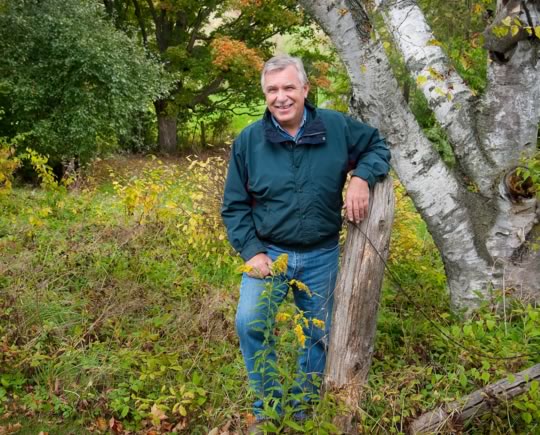Where the Moose and the Elk Used to Roam
Wildlife populations in Dufferin and Caledon have come and gone over the past few centuries, most dramatically since European settlement. Some species have vanished from the landscape. Others have arrived. Now things are changing again.
In about 1600, the wind-blown seed of a white cedar settled into a crack in the scarp face at a place that would one day be called Mono Cliffs Provincial Park. The seed germinated, drawing moisture and minerals from the small amount of organic matter in the fissure. Over time, the cedar’s questing roots sought out other cracks and fissures, finding just enough nourishment to survive. It grew, but only in tiny increments year by year. Today, gnarled and twisted, the tree is dwarfed by the much younger cedars in the forest above the cliff.
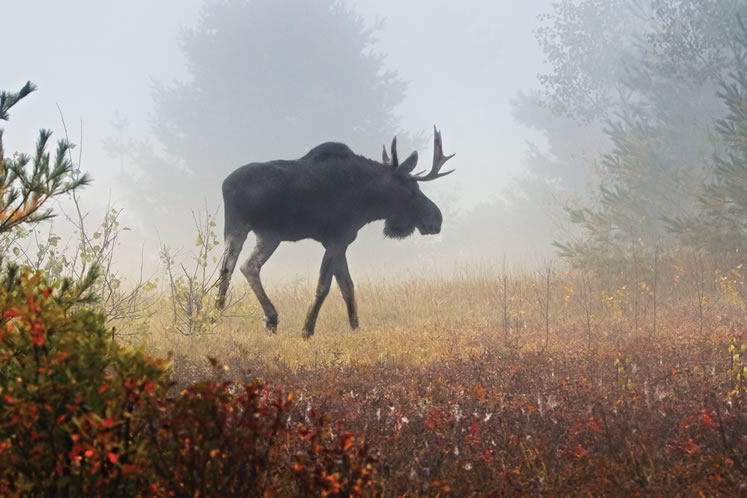
Moose were among the many animals that once roamed freely here before they were vanquished by European settlement, along with their forest home. Photo by Robert McCaw.
Still, the seemingly inhospitable cliff face is a good place to be – if success is measured by longevity. In fact, many of the cedars at Mono Cliffs and elsewhere along the Niagara Escarpment are centuries older. The oldest, dubbed “the Ancient One,” tops a mind-boggling 1,300 years! The Mono Cliffs cedar, entering its fifth century of life, may live on far into the future.
During the cedar’s 400-plus years, it has changed at a glacial pace. Not so, however, the surrounding landscape, nor the flora, fauna and people living in that landscape. When the cedar’s seed germinated, no European settlers lived in Ontario. But there were people, of course. Over the first 250 years or so of the tree’s life, First Nation people travelled, foraged and hunted on the land where it grew. Then, as European settlers arrived in the 19th century, land was cleared, guns proliferated and the environment experienced convulsive change.
The upwelling of land between Lakes Ontario and Huron, including much of Headwaters, was once “a cool upland of deep forests,” wrote John Riley in The Once and Future Great Lakes Country. The trees of those deep forests remain familiar today: maple, hemlock, beech, birch, pine, ash and others. But a difference between then and now is the age and dimensions of some of those trees. Nearly all today’s woodlands have been cut at least once. Aside from the escarpment cedars, truly old trees are a rarity. Before European settlement, trees had a chance to age into charismatic giants.
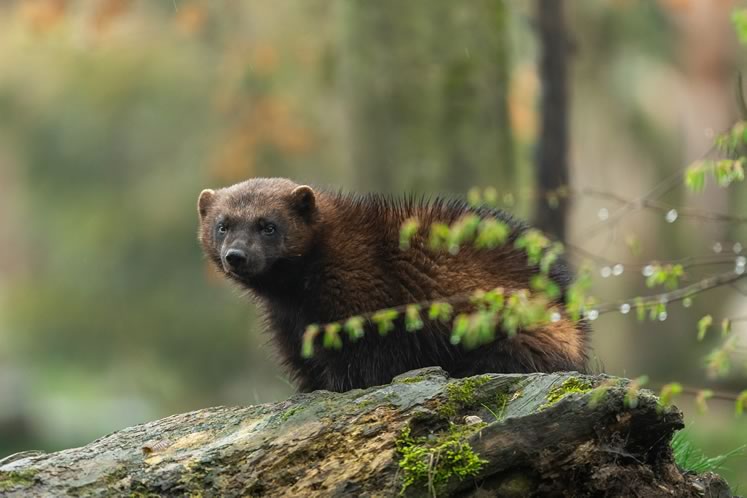
Long gone from Headwaters, wolverines were last recorded in southern Ontario in neighbouring Grey County in 1889. iStockphoto 1142788643.
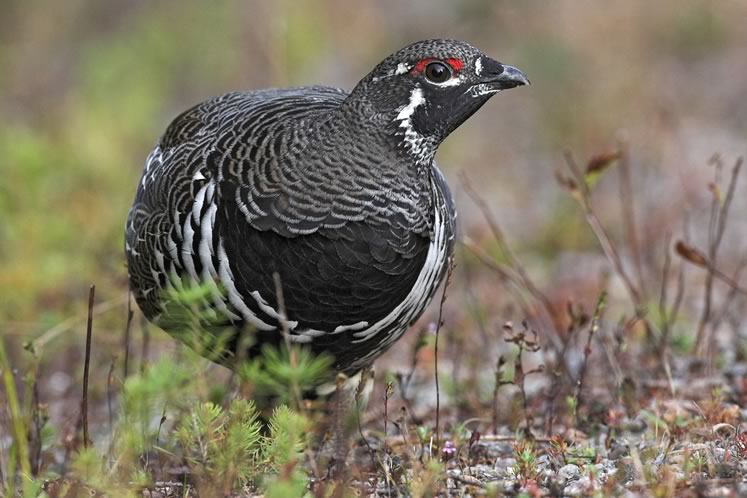
Once “plentiful in the vicinity of Orangeville,” spruce grouse are now found only in northern Ontario. Photo by Robert McCaw.
These old-growth forests were verdant, leafy places providing habitat for a cast of animals that have either disappeared from the Headwaters region or been reduced to a tiny fraction of their former numbers. The animals would have included elk, moose, wolves, martens, fishers and even wolverines, last recorded in southern Ontario in Grey County in 1889, according to Ontario’s Wolverine Recovery Strategy. And although two species of grouse once populated Headwaters, only the ruffed grouse has managed to hang on. The spruce grouse, once “plentiful in the vicinity of Orangeville,” according to the Atlas of the Breeding Birds of Ontario, 2001–2005, is now found only in northern Ontario.
The former presence of these animals can help us imagine the Headwaters landscape before intensive settlement. Spruce grouse, for example, like to live in forests dominated by spruce and Jack pine. So two centuries ago large tracts of coniferous forest were probably common here.
Wolverines now live only in the wildest places – northern Canada and the Rocky Mountains. They appear unable, or unwilling, to live in settled landscapes. That this formidable predator once ambled through these hills demonstrates just how wild the landscape was in precolonial times.
Similarly, the presence of elk before European settlement suggests not all southern Ontario was solidly cloaked in forest. Though elk will live in forest, they thrive in open habitats where they can find plenty of forage.
A walk through a Headwaters forest in 1720 would have been different from a hike through a woodland in 2020. In the 18th century, prudence would have guided your footfalls. Massasauga rattlesnakes lived in wetlands in northern Dufferin and Wellington counties, and intriguingly, timber rattlesnakes – the larger and more heavy-bodied relatives of the massasauga – may have inhabited the region as well.
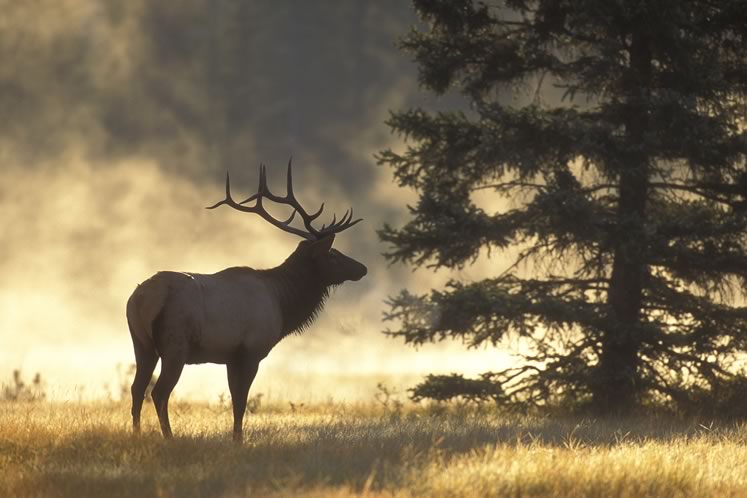
Elk prefer open spaces, and their presence in precolonial Headwaters suggests the region was not solidly cloaked in forest. Photo by Robert McCaw.
Formerly abundant in local waterways, Atlantic salmon were lost to overfishing. A concerted program called Bring Back the Salmon is attempting to restore them. Salmon Illustrated By S.F.Denton : Rawpixel CC By 4.0.
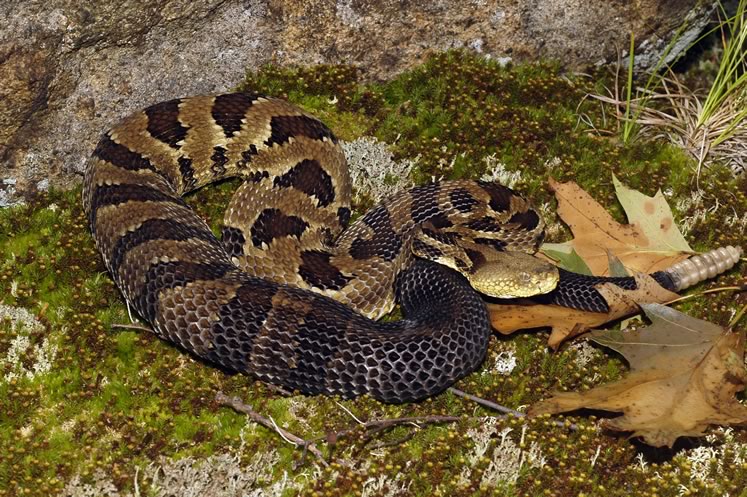
Although timber rattlesnakes are non-aggressive and didn’t deserve the bad rap that led to their extirpation in Ontario, the possibility of encountering one tended to sharpen the senses. Photo by Alex Figueroa CC BY-NC-SA 2.0.
One of these impressive pit vipers was once recorded near Rockside in Caledon. And though timber rattlesnakes are non-aggressive and not at all deserving of the fear and loathing that led to their extirpation in Ontario, the possibility of encountering one tended to sharpen the senses. So did the presence of bears and cougars, even though these animals are very rarely aggressive toward people. Walking a precolonial woodland would have been akin to walking in a city today, when sensible caution guides our interactions with cars and trucks.
Not all fauna that were once common have disappeared. Mosquitoes, for example, continue to pester us today, just as they tormented people 200 years ago. At that time, however, there was a potentially lethal twist. Malaria, which is spread by mosquitoes, was common in Upper Canada (present-day Ontario) in colonial times. The malady “was so common in the period from the 1780s to the 1840s that it was considered remarkable if any newcomer failed to acquire the disease within a year or two. Rich or poor, old or young, almost all suffered with ‘fever and ague,’” notes the Canadian Encyclopedia.
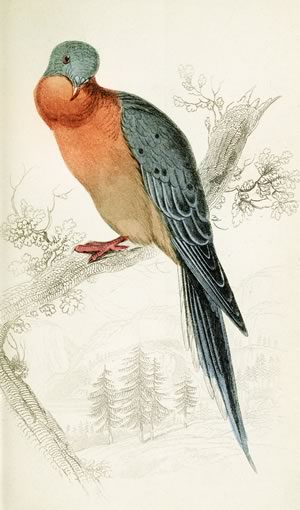
Flocks of passenger pigeons, now extinct, once formed “biological storms” in the skies above our hills. Illustration by W.H.Lizars : Biodiversity Heritage Library CC BY-NC-SA 2.0.
Though the overall mortality rate for the particular variety of malaria was low, the disease could still be deadly. From 1826 to 1832, when the Rideau Canal was being built, malaria may have killed as many as 500 workers. In the workers’ crowded quarters, a mosquito that sucked up the malaria-causing parasite while feasting on an infected person’s blood could easily transmit the disease when it bit other workers. Those who died, however, may already have been weakened by other diseases endemic at the time, including dysentery, smallpox and tuberculosis.
The reason malaria arrived in colonial Ontario is open to speculation. British soldiers, formerly posted in the tropics, may have brought it here, but this theory has been disputed. Also shrouded in mystery is the reason it disappeared from the province and, in fact, from most of North America. It’s a loss not mourned.
In this magazine, Chris Wedeles wrote in 2012 about passenger pigeons, which were abundant in Headwaters during the colonial period – until land clearing and an orgy of shooting led to their rapid demise. These hills were prime habitat for these birds. In The Passenger Pigeon in Ontario, Margaret H. Mitchell reported that a nesting colony in Mulmur covered an estimated four square miles. Another near Luther Lake was said to contain millions of breeding birds. There is simply no analogue today that can help us grasp these numbers, at least in North America.
Famed conservationist Aldo Leopold, writing in A Sand County Almanac, described the passenger pigeon this way: “The pigeon was a biological storm. He was the lightning that played between two opposing potentials of intolerable intensity: the fat of the land and the oxygen of the air. Yearly the feathered tempest roared up, down, and across the continent, sucking up the laden fruits of forest and prairie, burning them in a travelling blast of life.”
Here in Headwaters and throughout eastern North America, these “biological storms” of passenger pigeons once nourished large numbers of owls, hawks and mammalian predators such as wolves, bobcats and weasels, as well as hosts of insects and scavengers. All these pigeon-dependent creatures were entwined in a great food and energy web, a fecund and vibrant biology now extinguished.
The profound effect of passenger pigeons on the environment wasn’t limited to the birds themselves and the animals they fed. By “sucking up the laden fruits of forest and prairie,” passenger pigeons also influenced the distribution and abundance of trees, shrubs and herbaceous plants. They ate, for example, a smorgasbord of berries – dogwood, grape, winterberry, pin cherry, raspberry, partridgeberry, elderberry, blueberry – essentially every berry that grows here in these hills and beyond. We can only guess at how our flora might be different if passenger pigeons were still around to distribute seeds through their droppings.
Atlantic salmon, too, must have greatly influenced the ecology of the Credit and Humber watersheds in Headwaters. The sheer biomass of these fish, wriggling upstream from Lake Ontario to spawn in the autumn, was astounding. References to their abundance fill early journals. Their ecological links must have been similar to those of Pacific salmon today – connections that nourish bears, otters, eagles and a multitude of scavengers, such as ravens. The decline and eventual extirpation of Atlantic salmon from Lake Ontario by the end of the 19th century deprived predators and scavengers of huge amounts of nourishing protein.
Ecological connections include human beings, and the disappearance of the salmon was especially poignant because it visited great hardship on the Mississauga, the Anishinaabe people who lived north of Lake Ontario at the time of European settlement. The Mississauga traditionally encamped along the Credit and Humber rivers during the salmon runs. The harvested salmon helped fill their winter larders. And as the market economy took hold, the Mississauga began selling part of their catch to settlers in the growing communities of 19th-century Ontario.
As early as the late 18th century, however, the Mississauga were becoming concerned about the future of their salmon fishery, and in 1829 they petitioned the lieutenant governor of Upper Canada to respect their negotiated fishing rights along the Credit River. Settlers were trespassing, taking great quantities of fish and treating the Mississauga with contempt. The urgency and desperation expressed in the petition was heartbreaking:
“We sold a great deal of our land to our great father the King for very little and we became poorer and poorer. We reserved all the hunting and fishing, but the white men soon grew so many that they took all: when the rest was gone we kept the ten mile creek, the twelve mile creek and the river Credit. The two first are gone from us, but we are wishing to keep the Credit. We reserved one mile on each side of the Credit, where we now live … We now want the fish in our river, that we may keep our children at home to go to school, and not go many miles back to hunt for provisions.”

Cougars once prowled in Headwaters, but despite occasional unverified sightings, there is no indication they have returned. Photo by Robert McCaw.
The petition included this simple request: “Now, Father, once all the fish in these rivers and these lakes … were ours; but your red children only ask you to cause laws to be made to keep these bad men away from our fishery at the River Credit.”
The colonial government responded with laws to protect the fishing rights of the Mississauga along the Credit. Alas, those laws were ignored.
The fate of the Atlantic salmon in the Credit and Humber rivers was sealed by overfishing, dam construction and the effluent from saw and grist mills. The salmon disappeared, ending the Mississauga’s hope of wresting a living from the land in traditional ways, by hunting, fishing and foraging. Like the Atlantic salmon, the other animals the Mississauga relied on were also undergoing catastrophic declines as precolonial forests and wetlands were converted to agriculture, and a full-blown slaughter of wildlife took place.
Carver Simpson, who lived on a farm in East Garafraxa, may have been a typical hunter. Simpson’s journals for 1878 and 1881–82 suggest, as was probably the norm for young farmers in that era, he had an impressive repertoire of skills. The tasks and projects he completed, and casually mentions in his journal, were remarkably diverse. Though farm life kept Simpson busy, he did find time for recreation – and one of his favorite pastimes was hunting. Caledon Lake was a favoured destination for shooting waterfowl.
In Simpson’s era, before any prevailing environmental ethic, everything was fair game. The young man recorded shooting crows, ducks, partridges (grouse), blackbirds, skylarks (horned larks), snowbirds (snow buntings), hawks, sparrows, meadowlarks and woodpeckers. Once he even shot a “tomtit,” which was likely the little bird we call a chickadee. Taxidermy was one of his skills and he stuffed the tomtit, as he did many of the animals he shot and trapped.
He also shot passenger pigeons. Though he referred to them as pigeons, an excellent sketch – Simpson could also draw – shows the unmistakable image of one of those now extinct birds. In September 1882, he shot five. The date is notable. It comes 10 years after a man named Robert Reid, in Camilla at the time, recorded the final “large flight” of passenger pigeons in Dufferin County. And the 1882 date precedes by 17 years the most recent reference I could find to passenger pigeons in Headwaters: “a flock of ten seen on Easter.” The observer, named Calvert, recorded this sighting in Orangeville in 1899.
Simpson also shot and trapped mammals, including rabbits, groundhogs, squirrels, weasels, mink, foxes, skunks and muskrats. The presence of these mammals in late 19th-century Dufferin is unremarkable. They were common then and remain common today. What is notable, however, are the animals not mentioned in Simpson’s journals – no beaver, no wolves and, astonishingly, no deer.
Simpson was a keen observer of wildlife. He recorded incidental sightings of birds and animals he shot at and missed, as well as others too distant to shoot. He also noted an unsuccessful bear hunt undertaken by some friends. It’s unlikely Simpson saw deer, beaver, and wolves in the East Garafraxa countryside and failed to mention them. Far more likely is that these animals were simply gone.
Simpson doesn’t mention coyotes either, an omission easy to explain. At the time, these western relatives of wolves were unknown in the area. But given a chance, wolves will kill their smaller canine competitors, and as wolves disappeared and forests were cleared for farming, coyotes started moving in from the West. The first documented record of a coyote in southern Ontario was one shot in Lambton County in 1919, according to zoologist Hugh R. MacCrimmon in Animals, Man and Change.
Wolves, however, were still common in Upper Canada in the early 19th century, according to Upper Canadian businessman, journalist and politician Charles Fothergill. In 1830 he wrote: “Of this well-known destructive animal it is needless to say anything in this place, further than that I am sorry to remark its numbers have greatly increased in the Upper Province of late years and that some strong legislative enactment is absolutely necessary to preserve our farmers from their depredations.”
In fact, the first wolf bounty in Upper Canada was enacted in 1793, at the same time as a bounty on bears. Various wolf bounties continued for nearly 200 years until repealed in 1972. The bounties, coupled with land clearance and the loss of prey animals, yielded the result Fothergill desired. Wolves became scarce and their lack of mention in the pages of Simpson’s journals suggests they were gone from southern Dufferin County by 1879.
As for beavers, also absent from Simpson’s journals, the European traders’ rapacious demand for furs fuelled overharvesting in the 18th and 19th centuries. Beavers were eliminated in many places, probably including Simpson’s bailiwick in these hills. And deer? It’s hard to fathom that these common animals were either rare in or completely absent from this region 150 years ago. But so it seems, as biologist Gaston Tessier, writing for the Canadian Wildlife Federation, noted, “In colonial times, people regarded all natural resources as inexhaustible. Because of this attitude, deer populations came to the brink of disaster in the 1800s.”

Martens were among the many animals that evacuated the region with the demise of their old-growth-forest habitat. Photo by Robert McCaw.
An example of the profligate slaughter of wildlife of the time was described in A Vacation Tour in the United States and Canada, published in 1855 by British writer, historian and scientist Charles Richard Weld. The activity Weld witnessed, euphemistically called a “squirrel bee,” was conducted in the woods near Lake George, New York. The objective of the “bee” was simple: Go to the woods and shoot anything that moves. Here, according to Weld, is the grim tally: “1 wild cat, 7 red foxes, 29 raccoons, 76 woodchucks, 101 rabbits, 21 owls, 42 hawks, 103 partridges, 14 quails, 39 crows, 4,497 gray, red, black, and striped squirrels, 25 wild ducks, besides unnumbered pigeons, jays, woodpeckers, &c.”
Little wonder that the Headwaters region – and much of eastern North America – was impoverished of wildlife by the time Carver Simpson began writing journal entries in 1878.
Since Simpson’s time there has been a modest rewilding. Attitudes toward wildlife have undergone a sea change. Most of us, including hunters, have embraced a conservation ethic that values the lives of other creatures. Even predators, once demonized, are now generally accepted. Hunting and trapping regulations ended the wholesale slaughter of wildlife. The maturation of existing forests in these hills and the return of marginal farmland to woodland has improved habitat. And Headwaters’ rivers are running cleaner, thanks among other things to pollution control and protected tree cover in their valleys and on their floodplains.
Deer and beaver are thriving. Fishers are returning. Turkeys, once extirpated, but reintroduced in the 1980s, have done so well that some consider them a nuisance. Ravens once again nest on Niagara Escarpment cliffs. Various hawk species, formerly shot at every turn, are becoming common. Bring Back the Salmon, a joint initiative of the Ministry of Natural Resources and Forestry and the Ontario Federation of Anglers and Hunters, as well as many other partners, is attempting to restore the Atlantic salmon runs to Lake Ontario streams.
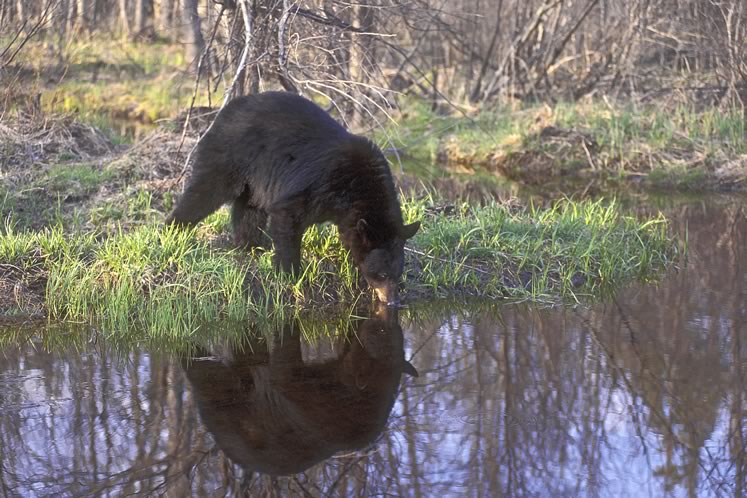
A bounty on both black bears and wolves was enacted in 1793, leading to their long-term disappearance from the local landscape. Photo by Robert McCaw.
Black bears, too, seem to be moving back into these hills. Once a rarity, bear sightings have increased in recent years. These forest dwellers have been spotted at locations throughout Dufferin County, as well as in Erin and the northern reaches of Caledon. (There are also occasional reports of cougar sightings, though none has ever been verified by photo, track or scat.)
Still, the living landscape around the 400-year-old cedar at Mono Cliffs Provincial Park is a mere shadow of what it was before colonization. The diversity and sheer quantity of wildlife is much reduced.
It is entirely possible that the Mono Cliffs cedar will survive and cling to the escarpment face for several more human lifetimes. In coming years, reforestation, population growth, climate change and conservation initiatives will affect the ecology of Headwaters, for better and for worse. The cedar will continue to bear silent witness to further dramatic transformation.







